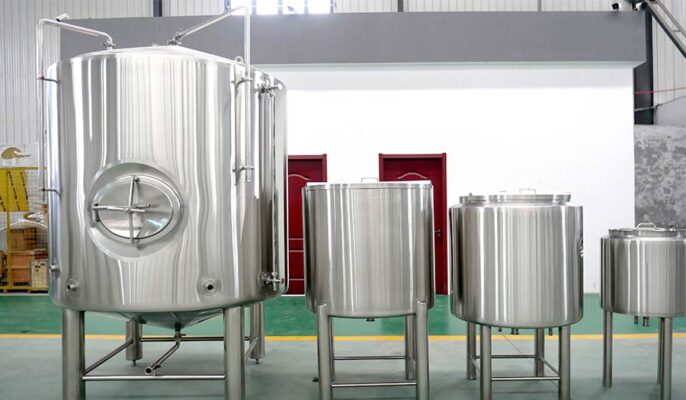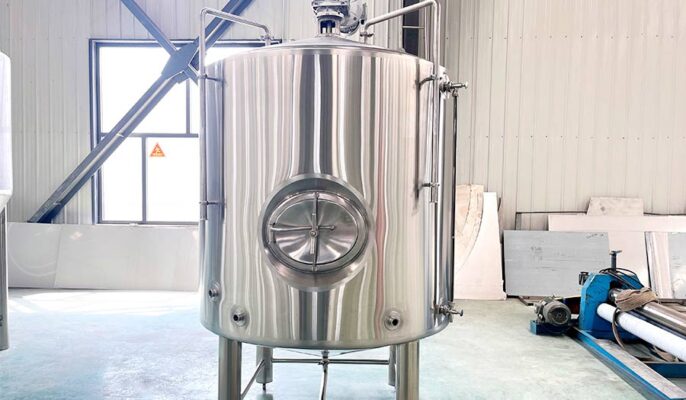As one of the cross-cultural and cross-time beverages, beer has a complex brewing process. One of the key stages is carbonation. It transforms beer from a still liquid to a vibrant, tantalizing palate. Bright tanks allow for more consistent carbonation levels and help improve beer clarity. Additionally, using beer cans helps reduce the amount of oxygen your beer is exposed to, thus helping to extend its shelf life.
What is a bright tank?
A bright tank is a pan bottom pressure rated temperature controlled tank, usually made of stainless steel, in a cylindrical shape. Used to hold beer in preparation for packaging. The term “bright” refers to “bright beer”, that is, beer that has been made bright (clarified) by filtration, centrifugation, clarification or aging. In most breweries, the beer will be filtered after it leaves the single tank or beer tank and directed into bright tanks. Beer cans are often fitted with beer stones, which are small pieces of calcium oxide that help remove beer fog.

Bright Tanks and Carbonation
Beer can be force-carbonated or carbonated in bright tanks. Forced carbonation is usually used for beer in kegs or cans. Natural carbonation is often used in bottled beer.
After beer is carbonated, it can be packaged in kegs, cans or bottles. Beer packaged in kegs can be transferred from the beer tank to the keg using a beer line. Beer in cans or bottles usually needs to be transferred to packaging containers, such as bottling kegs or canning machines.
Bright tanks are an essential part of any beer brewing operation. They can help improve beer clarity, reduce oxygen exposure and ensure consistent carbonation levels. When choosing a tank, it is important to consider the size, shape and material of the tank.
Factors Affecting Carbonation
A range of factors come into play when determining the duration of carbonation in a bright tank.
Beer style
Different styles of beer have different levels of carbonation. Lighter beers, such as beer, exhibit higher levels of carbonation than heavier beers, such as ales or stouts. Thus, the length of the carbonation process may vary.
Carbonation method
There are two main methods used by breweries: natural carbonation and forced carbonation.
Natural Carbonation: When relying on natural carbonation, the process may last from a week to several weeks. The residual yeast works at its own pace, producing carbon dioxide.
Forced Carbonation: With forced carbonation, breweries can speed up the process, often achieving the desired carbonation within a few days.
Temperature and pressure
Temperature and pressure act as conductors in a carbonation symphony. Lower temperatures favor carbon dioxide uptake, while higher pressures speed up the process. Careful monitoring is essential to avoid overcarbonation, which can lead to excessive foaming or explosion of beer.
PH and Gravity
The beer’s pH and original gravity affect its ability to absorb carbon dioxide. Beers with a higher pH and lower original gravity are generally more carbonated.
Carbonation equipment
The design and efficiency of the carbonation equipment play an important role. A well-designed system ensures that the carbon dioxide is distributed throughout the beer, helping to maintain a consistent level of carbonation.

Bright Tanks FAQ
What is a brite tank?
Vessels for beer maturation, clarification and carbonation. It is named for the clear and bright beer it produces after use.
It is usually equipped with some kind of carbonation system designed to reduce carbonation time. Most breweries use bright beer cans for serving containers and general storage.
How many bright tanks do I need?
The number of clear beer tanks required varies according to the duration of the fermentation process and the volume of the tanks involved. breweries have one beer tank for every four to five fermentation vessels.
How long does it take to carbonate in a bright tank?
The duration of the carbonation process depends on many factors, some of which are the carbohydrate restriction desired and the carbon dioxide pressure used.
A bright beer can takes about a day or two to clarify and carbonate the beer, depending on the amount of carbon dioxide required. Commercial breweries speed it up by forcing carbonation.
A typical fermentation vessel takes about two weeks to achieve the same effect that a bright tank achieves in a few days.




